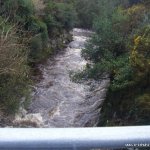Kip (Loughkip) River
| Grade: | 3 to 3 | Rating: |  |
|||
| County: | Galway | Date updated: | 10/10/2009 | |||
| Section Length: | 0.9 KM | Version: | 5 (History) | |||
Brief River Description
The Kip River (Loughkip) is a short, low volume, rocky run. The river is very narrow with lots of trees, from start to finish you might only catch three eddies.On high water this is a fast fun run. It takes no time to run this river, and itís so close to Galway; this makes it an accessible run that can be done with only one car because of its length.
Directions to the Put-in
To get to the river Kip head out of Galway towards Clifden, on the Clifden road, the N59. Drive 10Km out. You will cross a narrow bridge before you come to Moycullen. There is a green sign for the Lough kip River. Take the first left when you go over the bridge.The river is on the left. Drive about 500M up the road, until you reach a house on the left that has a wire fence and a long garden. The put in is anywhere that you can get to the river. The most common get in is just below or at the bottom of the garden of the house.
Directions to the Take-out
The take out is at or below the bridge at the bottom, beside the main road (N59).
500M below the bridge on river left there is a slow bend on in the river, with a man made boulder wall on river right. On river left there is a pathway that leads up to a small road, you can then walk back to your car.
River Description
The river starts from a bog, and meanders down to the area near the bridge where most of the gradient occurs. The first house on the left when you drive up from the bridge is where the rapids start. The river can be easily inspected at many points from the road side (some bush whacking necessary).
When you put on the river the first rapid is a nonstop rock dodge. Itís quite difficult to scout this section from you boat. Pinning is the main problem. On high water this isnít as much of a problem, but it speeds up the run substantially.
The next rapid is preceded by a pool with a concrete wall surrounding the river left eddy. The next rapid starts with a steep slide, which has a stopper at the bottom (on higher levels this may be sticky). The slide has to taken at an angle because of overhanging branches at the bottom (this makes it more fun). The stopper is left of centre, and the branches overhang on river right. The remaining rapid is straight with several boulders and small stoppers; it can easily be inspected from the top of the rapid.
The next rapid is smaller and have less gradient but have large boulders and have low overhanging branches.
Below the bridge the river changes character, it widens up and there are less overhanging branches. There are several nice rapids, with some holes, which we have been told get very sticky on high water.
Local issues
None. The locals are friendly and the family that owns most of the land on the river left bank, has a son who kayaks.
The pathway and the land after the bridge are on private property, so if you're in doubt ask a local. Having said all that, the situation is fine, park properly, respect the locals and make sure that the situation stays the same way.
River level gauge
The level can be judged from the bridge. If the rapid there looks runnable then the rest should be. If it looks like a scrape, don't bother.
The river needs rain, on the day that you are running it. The water runs off this river quite quickly, but there is some room for a few hours delay, so if its been raining earlier in the day it's worth getting out there and checking out.
However, the ideal time to catch this river is when it's raining heavily.
River Hazards
Trees and boulders (pinning) are the main hazards. It might be worth spending 10 minutes walking the bank checking for fallen trees before you run the river. This is due to the continuous nature of the rapids.
I was told that on high water levels that there might be a very sticky hole after the bridge that might be worth setting up safety on. So on huge water check this out.
Author(s)
Original Author: Seanie ByrneLatest Author: JK
(Full History)
Please add river details by adding to/editing the guide.


